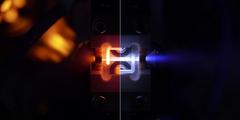Montage of two photos during the operation of the plasma lens: with helium (red) and argon (blue) (photo: C.A. Lindstrøm, Univ. Oslo).
An international team of researchers from Oslo, Oxford, DESY and CERN has overcome a major obstacle that has until now prevented the technical deployment of so-called plasma lenses. The group has presented the simple solution to this problem in a paper published in the Physical Review Letters. This paves the way for using such lenses not only in plasma accelerators but also in conventional accelerators employed in photon science or particle physics.
The high field strengths which arise in plasmas can be used not only to accelerate electrically charged particles, but also to focus particle beams. In a so-called active plasma lens, a strong current passes through the plasma along the path of the particles, creating a magnetic field vortex. In contrast to classical quadrupole magnets, this field can simultaneously focus the height and the width of the particle beam. Along with their high focusing power, due to the strong magnetic fields, this makes such lenses extremely attractive for use in particle accelerators. However, a key problem has so far prevented such a deployment of plasma lenses: an optical flaw in the lens destroys the focus of the particle beam as it passes through the plasma cell. This so-called aberration occurs because zones of different temperatures form within the plasma when the plasma is heated by the current flowing through it and at the same time cooled by the outer walls of the plasma cell. As a result, the strength of the focussing field varies in different regions of the plasma, leading to the optical flaw in the lens. Until now, this aberration has occurred so quickly after igniting the plasma that it was not possible to use the plasma lens to focus a particle bunch before the lens developed the flaw.
The international group of scientists has now found a solution at one of the test beams at the CERN accelerator CLEAR, overcoming a problem that has been around for many years and until now blocked the concept of the plasma lens: they simply switched the type of gas used to create the plasma from the usual helium, a light gas, to the heavier gas argon. This slows down the conduction of heat within the gas for long enough to allow a bunch of particles to be focused immediately after the plasma has been formed and the current to the magnet has been switched on, without the quality of the beam suffering as a result. The plasma lens only begins to distort the beam after the bunch has passed through it. “An argon plasma is much more complex than a helium plasma,” explains the DESY physicist Jens Osterhoff, whose group came up with the idea of exploiting the lower heat conductivity and built the plasma lens to test the idea, “but this is not as crucial to its function as a magnetic lens as it is in particle acceleration. Here, the property of being a poor conductor of heat is the key factor.”
The results of the experiments mark an important step towards making active plasma lenses a standard component of future accelerators. In the more immediate future, the scientists are also planning to manufacture plasma cells for these purposes using a 3D glass printing process.
Original Paper








